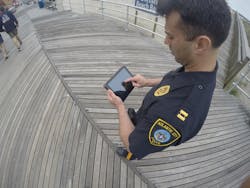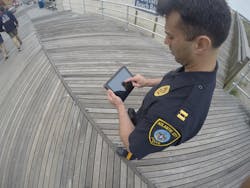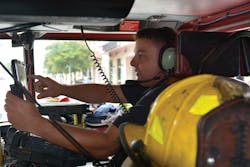FirstNet: The third dimension of public safety wireless
FirstNet will be a wireless network for first responders that’s as robust and reliable as land mobile radio has been.
By Art King, Corning Inc.
FirstNet is the third dimension of public safety wireless. Wait—the third dimension? What are we talking about? Over the last several years, our changing public safety wireless landscape has grown from a single dimension of land mobile radio (LMR) to three dimensions we seetoday.
- LMR—Traditional narrowband devices like walkie talkies and equipment carried by first responders that operates in the 150-, 450-, and 800-MHz commercial spectrum. Public safety has been anchored on LMR since the 1930s, when car radios and public safety networks were first pioneered. The 3-KHz-wide voice-only service constraint of most LMR systems has been recognized as a barrier to the more-advanced services that would benefit both first responders and the communities theyserve.
- FirstNet LTE—Interoperable LTE infrastructure that is adapted for public safety use and was first recommended by the 9/11Commission.
- Public LTE—Commercial LTE infrastructure offered by mobile operators to the public. The FCC Fourth Report and Order on E-911 Services (January 2015) clearly added more requirements to public LTE networks for public safety. Specifically, the Commission mandated that solutions to report an E-911 caller’s location to within 50 meters in “GPS denied” areas, usually indoors, to enable first responders to locate and service them be built into the publicnetworks.
What is FirstNet LTE?
There are many drivers for FirstNet, but at the core there is a desire to bring high-availability, innovative, and life-saving broadband service capabilities to the first responder. Because of the critical service demands, public LTE was found lacking in the capability to reliably support publicsafety.
FirstNet is operated on a separate national evolved packet core (EPC) network, which provides first responders their own private infrastructure. Photo credit: First Responders Network Authority.
Here are specific capabilitygaps.
- Preemption: On 9/11/01 when the World Trade Center towers collapsed in New York, LMR services were taken out due to loss of the base stations and repeaters installed in those buildings. And there was no way for first responders to use cellular as an alternative because the networks were jammed with subscribertraffic.
- Service availability: Inside many office buildings, cellular service may not exist or could be easilydisrupted.
- Location: Where are the first responders throughout the building? Demanded for large fires and active shootersituations.
- Innovation: iOS, Android, and broadband LTE service bring significant innovation possibilities to agencies of all types. In order to use these platforms for their responders, the underlying network has to always bethere.
The FirstNet architecture aims to holistically address the gaps in the public LTE networks to raise the availability and capability of LTE to the standards required for public safety. AT&T, which was selected to build and manage the FirstNet network (March 2017), is doing major work to deliver on the architecturalrequirements.
Here is a brief outline of the FirstNet LTE networkenhancement.
Core network—FirstNet is operated on a separate national evolved packet core (EPC) network. This provides first responders with their private infrastructure. This fosters the ability to create groupings by area, agency, and role that would be hard to layer onto the present public LTE core. FirstNet is advertised as Public Land Mobile Network (PLMN) 313-100.
Spectrum—Band 14 in 700 MHz has been allocated across the United States for public safety. Because of coverage/capacity issues, spectrum in use, non-Band-14 mobiles, and other factors, AT&T is advertising FirstNet on other available spectrum in an area. This approach was confirmed on Reddit in early 2018 with the FirstNet equivalent PLMN appearing in LTE messaging on AT&T bands other than 14. This allows the provisioning of FirstNet devices onto the FirstNet network’s EPC in advance of the availability of Band 14 infrastructure. Also, this enables older devices that are not Band 14-capable to participate in the FirstNet infrastructure as the cost of acquiring all new mobile devices is prohibitively expensive for mostagencies.
In a local or regional emergency, network access for first responders is prioritized through preemption. A network will recognize a FirstNet-enabled device profile and treat it correctly. Photo credit: First Responders Network Authority.
Preemption—In a local or regional emergency, cellular networks get crushed with traffic. Because networks have technology (a cell has finite resources) and business (no ROI) capacity limits, FirstNet participants had to lead the development of a strategy to prioritize network access for first responders. This strategy is called “ruthless preemption.” The good news is that most of the changes are in software such that new mobiles or base stations are not required. A FirstNet SIM should be the only requirement as the network will recognize a FirstNet-enabled device profile and treat it correctly. What does preemption actually do? In short, normal subscribers who happen to be attached to a Band 14 base station are preempted by a number of methods: shifting from a cell, disconnected, denied service, suffer reduction in resources, or barring. This preemption clears the Band 14 cell(s) impacted by the emergency so first responders have the best availableservice.
There are five parameter sets that are used by mobiles and base stations that govern how mobiles and their onboard apps will be treated by a congestedcell:
- Access Class—Normal, high priority, emergency
- Allocation and retention priority—Bearer streamsprioritization
- Preemption capability/Vulnerability indicators—Mobile ability to preempt or bepreempted
- QCI—Normal LTE signaling markers for end-to-end QoS/CoS
- Bit rate parameters—Differing mobile uses/apps to get appropriatecapacity
What does FirstNet LTE mean indoors?
So if we think about everything discussed so far about FirstNet, how will this impact those of us that support cellular deployments in office buildings, campuses, orvenues?
For signal distribution using DAS infrastructure, either public safety or cellular, decisions will need to be made on support for Band 14. If the headend and remotes cannot support Band 14, does the vendor have or plan to have it available? If so, what would the overall project cost total up to for Band 14 support upgrade? In some cases, a small cell overlay of Band 14 will be a more cost-effective solution and could bring additional benefits around locationservices.
At the headend of the DAS, a Band 14 base station or small cell signal source will be required to feed the DAS. High-capacity small cells are a great alternative to a full base station as far as resource consumption. For example, a low-cost 6-sector small cell installation occupies 5U (8-3/4 inches) of vertical space in a 19-inch equipment rack, uses two 110 VAC outlets, and generates around 650 BTUs of heat. Compared to the physical and HVAC footprint of a standard base station, small cells at the headend have merit. But no matter what is chosen for Band 14 support, it will be an approved system that is running software featuring the set of necessary preemption features for attached public safety mobiles and a dual core connection to public LTE and FirstNet LTE. Depending on the transport network configuration of the building, the existing IP network connection could be shared or an additional one installed to reach AT&T FirstNet security gateways at the border of the corenetwork.
Small cell overlays have their own features and benefits. The majority of vendors providing small cells use 1-Gbit/sec Power over Ethernet Plus (PoE+) as the network interface into the radio. This can simplify installation of small cells in standalone Band 14 applications. Things to watch for when selecting small cells when you’re in a GPS-denied area (small cells can’t see the satellite cluster) involve cabling for GPS. Some small cells don’t require GPS and don’t require a GPS cable (good). But for those that do, GPS cabling and signal distribution can add up to a mighty big number quickly (not sogood).
Finally, from a design perspective, authorities having jurisdiction (AHJ) may choose to apply additional availability features around environmental survivability and/or uptime after power loss. How these features will apply to the FirstNet design templates will sort themselves out overtime.
In this technology evolution, we are seeing the culmination of the desires of first responders to have cellular broadband capability that is as robust as LMR traditionally hasbeen.
In our world, there are huge numbers of projects to come that will add Band 14 capability to new buildings and retrofit older buildings so the day that a first responder has to take care of us, they can.u
Art King is director of enterprise services and technologies with Corning Inc.


